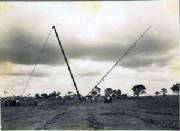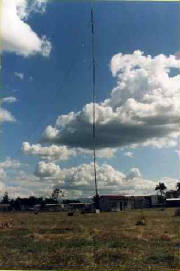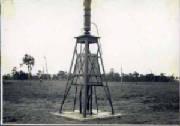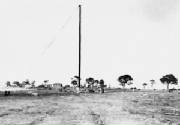|

|
| 1942 - erecting the Bald Hills mast for 4QG mediumwave |
Beginnings
The callsigns VLQ &
VLM were originally allocated to two ships in the registry of neighbouring New Zealand, and in more recent time, the callsign
VLM was in use as a line callsign for one of the transmitters at the temporary Carnarvon site in Western Australia. We might
also add that the callsign VLM was also in use for a 10 kW communication transmitter located at Pennant Hills in the pre-war
days, and the callsign VLQ was also in use at the same site for international broadcasting beginning in the year 1939.
1941
work commenced at Bald Hills, 20 km north of Brisbane, on a new radio base for the two ABC mediumwave
stations 4QG and 4QR. One of the major reasons for moving the antennas from the city into the country during the Pacific War
was so that the horizon as seen from the ocean would be considerably lower.
The location at Bald Hills is flat and
swampy and it was previously in use as a commercial jam factory. In May 1942, station 4QG was transferred from the top of
a city building to the new country location.
February 14 1943
The
first test broadcasts from the new 10 kW STC transmitter were heard on and strangely, the test announcement gave the
location as Sydney. Three days later, shortwave VLQ at Bald Hills was officially inaugurated and it carried the ABC programming
for outback areas.
1945
The ABC began a 15 minute daily news bulletin from VLQ for listeners
in Papua New Guinea. Some 30 years later, Radio Australia also took the same station, VLQ, into daily usage for a regular
five hour service to Papua New Guinea. The channel for this external broadcast was 11885 kHz though no callsign was allocated
for this transmission. The Radio Australia usage of VLQ for the service to Papua New Guinea was terminated in 1976 when the
new though temporary station was inaugurated at Carnarvon in Western Australia
September 7 1949
A
temporary additional unit was installed at Bald Hills for use on a lower frequency for coverage in the skip zone of the higher
frequency unit VLQ. This temporary unit was rated at 200 watts and it was opened without ceremony as VLM. Two years later,
a new 10 kW transmitter was installed and it took over the VLM service.
Back during the pre-satellite era, the shortwave
service from the two transmitters VLQ & VLM served a double purpose. It was in use as a direct broadcast service for people
living in isolated outback areas, and it was also considered essential as an emergency backup for outages in the tenuous landline
feeds to distant mediumwave stations. The VLQ relay service was heard at times from several of the distant ABC stations in
Queensland, and also from station 5DR at Darwin in the Northern Territory.
Over the years, a total of four different
shortwave transmitters were on the air at Bald Hills, three at 10 kW and one at 200 Watts. The three larger units were on
the air as VLQ and VLM, and also for the Radio Australia service to Papua New Guinea. The antenna system was made up of two concentric rhombics, two half wave dipoles, and an experimental folded dipole.
December
16 1993
This was the date of the last broadcast from this shortwave station and the newest transmitter was
sold a few months later to the ChronoHertz station VNG in Llandilo in New South Wales. However, station VNG has also subsequently
gone silent.

|
| 1986 - dismantling Bald Hills mast (mediumwave) |

|
| 1942 - Bald Hills - base of mediumwave mast |

|
| 1942 - Bald Hills mast (mediumwave) |
|

